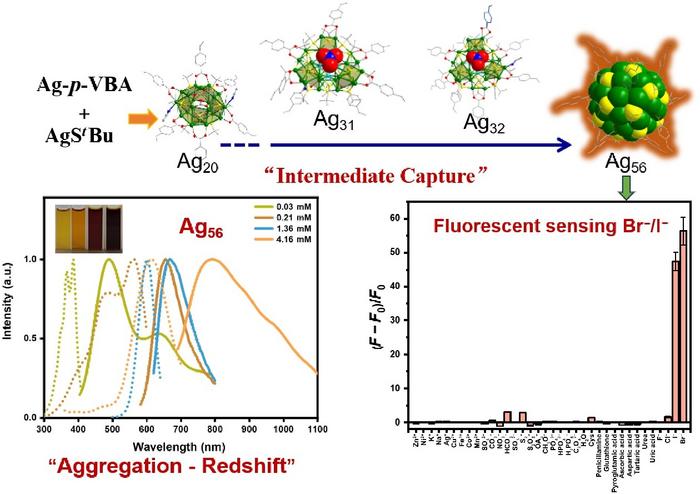
In a landmark achievement for nanomaterial science, researchers led by Professor Huayan Yang from Shenzhen University have successfully synthesized highly stable silver sulfide nanoclusters, particularly Ag₅₆, which exhibit remarkable properties for sensing applications. This groundbreaking study is crucial in the quest to develop advanced fluorescent materials with significant potential for use in modern biosensing and environmental monitoring.
The significance of this research lies not just in the synthesis of Ag₅₆ clusters but also in their unique optical properties, including near-infrared (NIR) emission and long Stokes shifts. These properties make the nanoclusters particularly valuable for sensing applications, as they allow for the detection of trace amounts of various ions, including bromide (Br⁻) and iodide (I⁻). The study’s findings may pave the way for the development of sensitive detection devices that can operate in complex biological and environmental matrices.
In their pursuit of these nanoclusters, the research team meticulously controlled reaction parameters such as temperature, ligand concentration, and solvent choice, allowing them to achieve high yields of synthesis while also capturing key intermediates along the way. This fine-tuning of conditions resulted in the successful synthesis of a series of silver nanoclusters, including Ag₂₀, Ag₃₁, and Ag₃₂, all the way to the desired Ag₅₆ clusters.
One of the most captivating findings from the research was the unique fluorescence aggregation-redshift phenomenon associated with these clusters. The π–π interactions between the ligands and the silver atoms contribute to this unusual optical property. As these Ag₅₆ nanoclusters aggregate, they demonstrate an incredible ability to facilitate a redshift in fluorescence–a phenomenon that enhances their functionality as sensors.
Moreover, the researchers engineered a fluorescence-based sensor utilizing the Ag₅₆ nanoclusters, which can detect low concentrations of Br⁻ and I⁻ ions with detection limits as fine as 85 nM and 105 nM, respectively. The operating range in the near-infrared spectrum not only minimizes background interference but also facilitates higher tissue penetration, making these sensors particularly advantageous for biosensing applications and in vivo diagnostics.
The published findings in the journal Polyoxometalates detail not just the synthesis and characterization of these novel nanoclusters, but also their applications for real-world ion sensing. This marks a significant contribution to the field, providing a platform for further explorations into the functionalities of silver sulfide nanoclusters in various sensing technologies.
Professor Yang’s insights elucidate the importance of their work, emphasizing how their study provides essential know-how regarding the controlled synthesis and potential applications of silver sulfide nanoclusters. The manipulation of optical properties through ligand engineering opens new avenues for the creation of highly sensitive and selective sensor platforms; paving the way for a huge leap in analytical chemistry.
This research is supported by numerous scientific grants, including those from the Shenzhen Science and Technology Program, as well as collaborative work involving several notable contributors from Shenzhen University and Hunan University of Science and Technology. The collaborative effort underscores not just the capabilities of the researchers involved, but also the importance of interdisciplinary approaches in advancing the field of nanotechnology.
The Ag₅₆ nanoclusters, due to their extensive Stokes shift and strong NIR emission properties, represent a noteworthy advancement in fluorescent sensing technologies. As the researchers look to the future, they aim for these developments to inspire further research into the design and applications of silver sulfide nanoclusters across a range of sensing technologies, thereby propelling forward the new era of nanomaterial applications.
In sum, this study highlights the transformative potential of silver sulfide nanoclusters in advanced sensing applications, showcasing the power of new materials in tackling some of the most pressing challenges in environmental monitoring and biomedical diagnostics. With their innovative and high-yield synthesis methods, the research team not only contributes to fundamental materials science but also addresses practical needs in real-world applications.
In conclusion, the synthesis of silver sulfide nanoclusters and their utilization in ion sensing is a fruitful frontier that opens up myriad pathways for future research, ultimately leading towards more efficient and sensitive analytical techniques critical for healthcare and environmental sustainability.
Subject of Research: Synthesis and applications of silver sulfide nanoclusters for ion sensing.
Article Title: From intermediate capture to functional cluster construction: Synthesis of silver clusters and their Br−/I− sensing applications.
News Publication Date: 25-Feb-2025.
Web References: Polyoxometalates Journal.
References:
Image Credits: Credit: Polyoxometalates, Tsinghua University Press.
Keywords: silver sulfide nanoclusters, ion sensing, fluorescence, near-infrared emission, biosensing, environmental monitoring, Stokes shift, optical properties, synthesis method, ligand engineering, silver clusters, analytical chemistry.
Tags: advanced fluorescent materials researchAg₅₆ synthesis processbromide and iodide detectioncomplex biological matrices sensingenvironmental monitoring technologiesligand concentration effects on synthesisnanomaterial science breakthroughsnear-infrared emission propertiessilver nanoclusters for biosensingsilver nanoclusters optical propertiessilver sulfide nanoclusters applicationstrace ion detection methods





